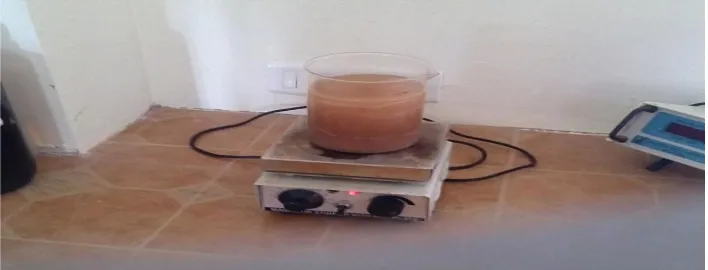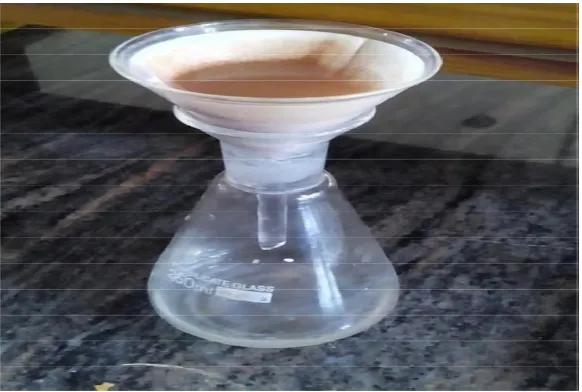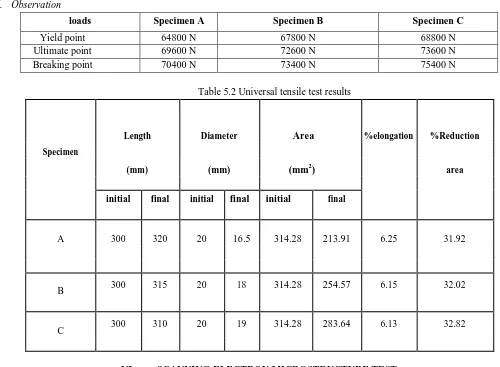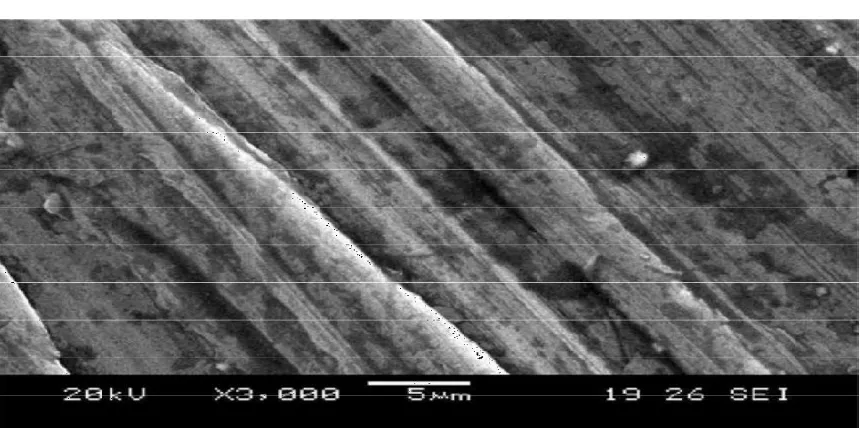Technology (IJRASET)
©IJRASET: All Rights are Reserved
409
Analysis of Mechanical Properties and Micro
Structure of Aluminium Matrix Hybrid Composites
with Alumina, Coal Ash and Graphite
A. Captan Prabakaran1, T. Harichandra2 1,2
Mechanical Engineering, Roever Engineering College
Abstract: A composite material is a combination of two or more different materials; it gives superior quality than its constituents. Composite materials can be used not only for structural applications, but also in various other applications such as automobiles, aerospace, marine, etc…The micro structural characteristics, mechanical properties of Aluminium matrix hybrid composites reinforced with alumina(AA6063), Coal Ash(CA) and graphite were investigated. Alumina, Coal Ash (CA) and graphite mixed in varied weight ratios were utilized to prepare composites using stir casting. Hardness, tensile properties, micro structural tests were used to characterize the
Composites produced.
Keywords: AA6063, Coal Ash, Graphite, Micro Structural tests, tensile test
I. INTRODUCTION
Conventional monolithic materials have limitations in achieving good combination of strength, stiffness, toughness and density. To overcome these short comings and to meet the ever increasing demand of modern day technology, composites are most promising materials of recent interest. Metal matrix composites (MMCs) possess significantly improved properties including hardness, tensile strength, compression strength and good wear resistance compared to unreinforced alloys. There has been an increasing interest in composites containing low density and low cost reinforcements. Among various discontinuous dispersions used, fly ash is one of the most inexpensive and low density reinforcement available in large quantities as solid waste by-product during combustion of coal in thermal power plants. Hence, composites with fly ash as reinforcement are likely to overcome the cost barrier for wide spread applications in automotive and small engine applications. Now days the particulate are reinforced.
Aluminum matrix composite are gaining importance because of their low-cost with advantages like isotropic properties and the possibility of secondary processing facilitating fabrication of secondary components. Cast aluminum matrix particle reinforced composites have higher hardness, tensile strength, compression strength and good wear resistance as compared to unreinforced alloys. Aluminum metal matrix composites are finding wide applications in automobile and aerospace because of their excellent combination of physical, mechanical and tribological properties. Primarily because of their high specific strength and stiffness, these composite materials could also be used in weight critical applications
Now days with the modern development need of developments of advanced engineering materials for various engineering applications goes on increasing. To meet such demands metal matrix composite is one of reliable source.
II. PREPARATION OF METAL MATRIX
There are three methods to manufacture metal matrix composites. They are,
A. Melt Infiltration
This method is used when high volume fraction and uniform distribution of the hollow particles are required. This technique can make ultra light Al-alloy matrix synthetic foams with a density as low as 0.8gm/cc. Phase change from the metal in liquid to solid state in the presence of the hollow reinforcement having different thermal properties. The temperature and thermal gradients may be controlled to an extent to alter the microstructure of the metal matrix synthetic foams
B. Stir Casting
Technology (IJRASET)
©IJRASET: All Rights are Reserved
410
casting methods and may also be processed by conventional Metal forming technologies. The characteristic of stir casting technique is given bellow.
C. Powder Metallurgy
A wide variety of particle types and volumes fraction can be incorporated in composites using powder metallurgy methods. Reactive metals, which are not amenable to liquid state processing. Can be used as the matrix material in the powder metallurgy method. This method is especially suitable in synthesizing synthetic foams containing low volume fraction of hollow particles.
III. PREPARATION OF AA6063 METAL MATRIX
Before casting the aluminum fly ash composite material the following steps are carried out
A. Removal of Carbon from Coal Ash
The coal ash contains the carbon particles which may cause the property of the composite into brittle material. To avoid the brittleness of the material, the carbon from the coal ash should be removed. The procedure to remove the carbon from coal ash is given below.
A 500 grams weight of coal ash sample was taken in a graphite crucible and allowed to preheat in the muffle furnace at 800◦C for 3
hours. At this temperature the carbon content from the fly ash are burnt out, the grey color coal ash became the sandal color after the heat treatment as shown in figure. After the heat treatment the coal ash brings to the room temperature. Then the separation of coal ash derivative is carried out at next step.
[image:3.612.153.472.333.429.2]
Fig 3.1 Nature of Coal Ash Heating
B. Coal Ash Derivative Extraction
The coal ash derivative from the coal can extract by using distilled water. It is estimated that coal ash derivatives are present to an extent of about 1 % in coal ash from thermal plants. The coal ash is washed in the distilled water at this time the silica in the coal ash is deposited in the bottom and the coal ash derivative is float in water then the coal ash derivative from the water is filtered using the filter paper.
Fig 3.2 Coal Ash Derivative Extraction
C. Filtration of Coal Ash Derivative
[image:3.612.128.482.527.662.2]Technology (IJRASET)
©IJRASET: All Rights are Reserved
411
figure Because of low density and hollow nature they float in the lagoons where coal ash is discharged. The float is collected;
further isolation is carried by froth flotation and dried. It was then dried at 110◦ C for 24 hours to get rid of water. Dried coal ash has
been sieved using the filter paper. The micron level coal ash derivative is filtered and stored at the top of the portion as shown in figure then finally it was preheated as say above
for the particular period to remove water from the fly ash derivative. The filtration of coal ash derivative is shown in figure.
Fig 3.3 Filtration of Coal Ash Derivative
D. Stir Casting
After extraction of Coal ash derivative is utilized to casting with the aluminum AA6063, graphite to make the aluminum metal matrix composite material. For casting, stir casting method is used for stirring the aluminum, graphite with the rice coal ash derivative for the proper and equal distribution of Coal ash derivative in the aluminum. Before casting, coal ash derivative is separated into three different compositions. The composition is based on the weight of the aluminum. Here we separate the coal ash derivative1kg of AL, 300g graphite. The coal ash derivative is separated at the composition of 1%, 1.5%, and 2% for 1 kg of aluminum.
The melting point of aluminum is in the range of 5820C - 6520C. The temperature of stir casting machine is set up at 8000C. After reaching the temperature of 6000C in stir casting machine, the aluminum 6063 is kept in a crucible. When the aluminum melts completely in a crucible, the argon(Ar) gas supplied. The Ar gas is supplied for restricting the reaction of molten aluminum with the environment. It avoids the oxidation of aluminum with the atmosphere
and restrict the formation of oxide layer. So the aluminum is easy to flow in a molten state. It is easy to pour of molten aluminum into the die.
The coal ash derivative at various compositions is mixed with the 1kg of molten aluminum 6063, 300g graphite. After putting the coal ash derivative in a crucible, stirrer arrangement is switched ON. The stirrer is rotated at constant speed for 10 minutes. During stirring process, 1 gm. Potassium Hexa FlouroTitanate is added to reduce the slag formation.
After complete mixing of aluminum and fly ash derivative, the casting is done by using rectangle die. The above process is only for 1% of coal ash derivative. The same process is continued for 1.5%, 2% coal ash derivative. The casting is taken for all the three derivative. One more casting is taken for 0% coal ash derivative i.e. aluminum, graphite is directly poured into the casting without adding any derivative.
Totally we take four casting. In that castings, three casting product is aluminum metal matrix composite and one is aluminum 6063 alloy. Mechanical testing is done for all the four casting product. We have to analyze tensile strength, hardness, tensile strength, compression strength, microstructure of casting product.
E. Table for the Sample Compositions
[image:4.612.153.444.146.342.2]Technology (IJRASET)
©IJRASET: All Rights are Reserved
412
SAMPLE.NO Al 6063(wt %) Graphite (wt %) CA (wt %)
A 93.58 5.62 0.8
B 82 16.5 1.5
[image:5.612.56.526.75.174.2]C 95 4 1
Table 3.1 compositions of composites
IV. TESTING FOR MECHANICAL CHARACTERISTICS
For determining the mechanical parameters between the four compositions the following testing are carried out tensile test, scanning electron microstructure test. Microstructure is shows the distribution of the filler material with the matrix material. The microstructure of the specimen is carried out by using the scanning electron microscope equipment.
V. TENSILE TEST
The tensile strength of mild steel is of prime importance to an engineer. Mild steel is used in many of the Civil Engineering Structures like bridges, railways, industrial buildings, water tanks, transmission towers etc. Mild steel is subjected to direct tension due to bending in some of the components used in the aforesaid structures. Determination of the shapes and sizes of these components requires the knowledge of capacity to deform consistent with specifications for safety and serviceability. These are obtained from the stress strain curve of the material.
The tensile test measures several of the most important engineering properties of materials
A. Precaution
1) Apply the load at a uniform rate and without any jerk.
2) Remove the extensometer when the yield point has just reached.
3) Do not use extensometer when testing grey cast iron. It may be used on the other metals, but care should be taken to remove it
before the specimen fractures.
B. Procedure
1) Test Piece: The cross section of the test piece may be circular, squire, rectangular or in special cases of any other form. Test pieces of circular sections are generally be made to the dimensions.
2) Note the dimensions of the composite material specimen and determine the average diameter of the middle parallel portion.
Draw a sketch of the specimen and enter the dimensional details.
3) Mark the gauge length as per specification and record it accurately. The gauge length should be symmetrical with the length of
the bar.
4) Grip the specimen vertically and firmly in the jaw of the Universal testing machine and adjust the machine to read zero. Select
the required Chart range by turning the capacity change wheel with the ram at the bottom of its stroke. Raise the ram a few mm by the quick setting control and set zero. Note that the zero will change as the ram rises due to the weight of the column of oil in the cylinder. Note that the grips do not protrude through the grip holders and insert the specimen not lesser than two thirds of the way into each pair of grips.
5) Attach the extensometer firmly to the specimen and adjust it to read zero.
6) Increase the load gradually to 250 kg, read the extensometer and record the reading on data sheet.
7) Continue loading at increments of 250 kg each time and record the extensometer reading at each increment of loading. This
loading should be continued till yield point is reached. This is indicated by extensometer showing high values of extension. Record the load at the yield point. This may not be at a 250 kg increment.
8) At this point remove the extensometer and continue the loading. With the help of the venire of the machine, or by using
dividers, record the extension at different values of load at intervals of 250 kg until fracture.
9) Note and record the maximum load attained and the breaking load.
10) Remove the broken pieces from the machine, and note and record the type of fracture. Fit the pieces together, measure the final
length between the gauge marks and record as L, on data sheet. Measure the final diameter at the neck and record.
Technology (IJRASET)
©IJRASET: All Rights are Reserved
413
Table 5.1 Universal tensile test
C. Observation
loads Specimen A Specimen B Specimen C
Yield point 64800 N 67800 N 68800 N
Ultimate point 69600 N 72600 N 73600 N
[image:6.612.47.547.91.458.2]Breaking point 70400 N 73400 N 75400 N
Table 5.2 Universal tensile test results
Length Diameter Area %elongation %Reduction
Specimen
(mm) (mm) (mm2) area
initial final initial final initial final
A 300 320 20 16.5 314.28 213.91 6.25 31.92
B 300 315 20 18 314.28 254.57 6.15 32.02
C 300 310 20 19 314.28 283.64 6.13 32.82
VI. SCANNING ELECTRON MICROSTRUCTURE TEST
Micro structural properties play a very important role in the field of engineering and science. These micro structural observations can be done by some different techniques, such as SEM, XRD, Optical, TEM, and XRD. Micro structure can be defined as it is the structure of a finished surface or a thin layer of a material as revealed by microscope above 25× magnification. The microstructure of a material can be further categorized into polymeric, metallic, ceramic and metallic and can enhance the physical properties such as Hardness, toughness, strength, corrosion resistance. [American Society of Metals (1985)]
[image:6.612.108.505.546.711.2]Technology (IJRASET)
[image:7.612.93.521.77.270.2]©IJRASET: All Rights are Reserved
414
Fig 6.2 SEM test for sample B
Fig 6.3 SEM test for sample C
The composite materials are various ratios used to analysis the mechanical characteristic of scanning electron microscope test. The above image is taken from metal matrix composite with aluminium, graphite, coal ash derivative. The image shows the distribution of aluminium, graphite, Coal ash in the metal matrix. The composite aluminium, graphite, coal ash derivative particle has occupied the grain boundary vacant sites. Some bigger particles mostly silica has also entered metal matrix due to absence of ceramic filter. The variations in particle sizes are distinctly seen in metal matrix.
VII. CONCLUSION
The conclusions were drawn based the experiments conducted to study the mechanical properties of AA 6063 hybrid metal matrix composites reinforced with Al2O3, Graphite and CA . The Composite material of AA 6063 reinforced with Al2O3, graphite and CA was successfully fabricated by using stir casting method. The experiment result the hardness and compressive strength were increased while the wt % of Al2O3, graphite and RHC with Al 6063 are varied.86.5 wt % of Al 6061, 1.5wt % of Graphite and 12 wt % of CA composition have yield better mechanical properties rather than the other two samples.
[image:7.612.98.528.294.508.2]Technology (IJRASET)
©IJRASET: All Rights are Reserved
415
surface tension. We have drawn various conclusions from the various calculations based on the different experimental testes. Hardness, tensile strength, scanning electron microscope test of the composites also showed the same results as like of toughness. As we increased the amount of ash it increases and after that goes down. The density of the composites decreased with increasing ash content. Hence these light weight composites can be used where weight of an object maters as like in the Aerospace and Automobile industries.
From the above test result it was clear that is the performance of mechanical characteristic is high in the graphite, Coal Ash derivative filler material. As compare to the aluminum alloy material directly the hardness, tensile strength, scanning electron microscope is high in the, coal Ash derivative filler material. So we can use the coal Ash derivative as the filler material for the higher efficiency. From the above results we find the taking sample having a good toughness, hardness, tensile strength, scanning electron microstructure and also having the low density comparatively alloys without reinforcement. So that these composites could be used in those sectors where light weight and good mechanical properties are required as like in automobile and space industries.
REFERENCES
[1] A.Baradeshwaran, R.FranklinIssac (3), ‘Experimental investigation on mechanical behaviour, optimization of wear parameters of B4C and graphite reinforced aluminium hybrid composites’, 23 June 2014.
[2] Arunkumar M.B and R.P.Swamy (4), ‘Evaluation of mechanical properties of Al6061,Flyash and E-glass fiber reinforced hybrid metal matrix composites’,vol 6,No 5,May 2011.
[3] NecatAltinkok and AslanCoban (5), ‘The tensile behaviour of Al2O3/SiC reinforced Aluminium based MMC produced by the stir casting method’, volume 2, No 5, May 2012.
[4] Simulation of the stir casting process by S. Naher,D. Brabazon,L.Looney, Centre for Engineering Design and Manufacture, Dublin City University, Dublin, Ireland, Journal of Materials Processing Technology 143–144 (2003) 567–571.
[5] Radhakrishna M. Ramachandra K., “Effect of reinforcement of flyash on sliding wear, slurry erosive wear and corrosive behavior of aluminum matrix composite”, Wear 262 (2007):




